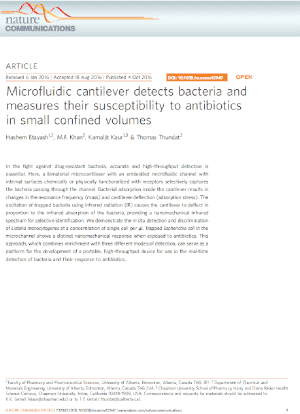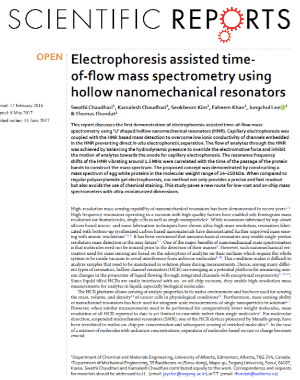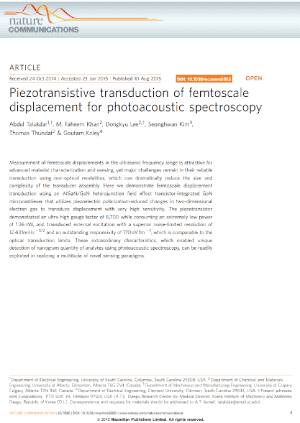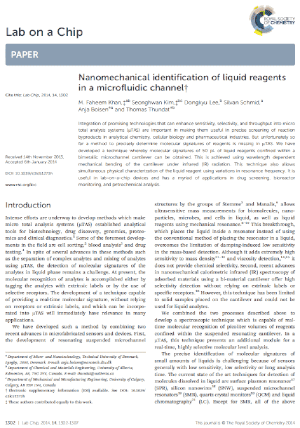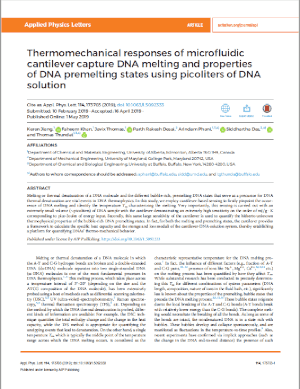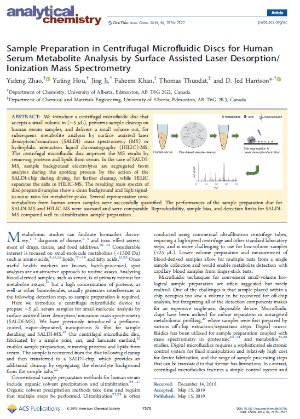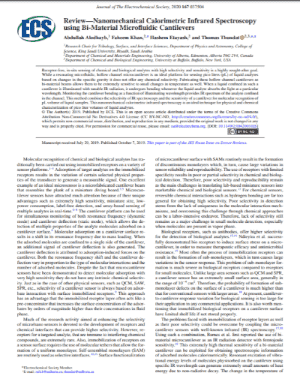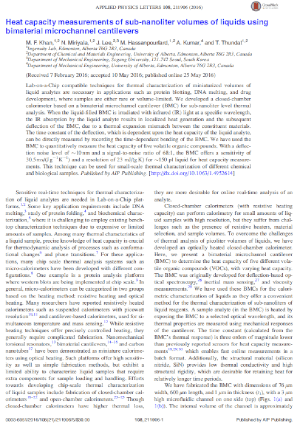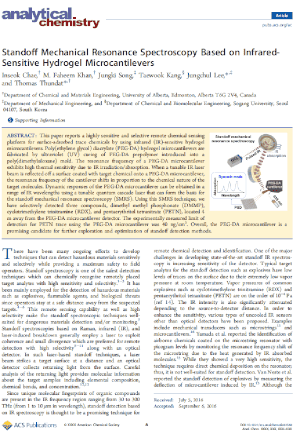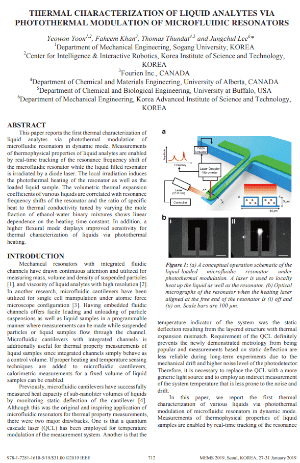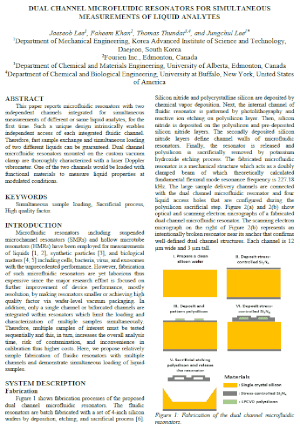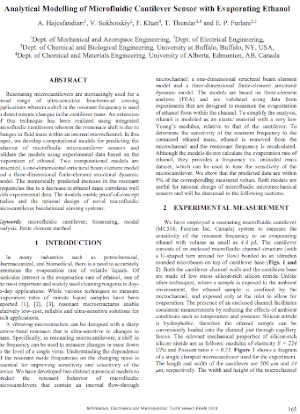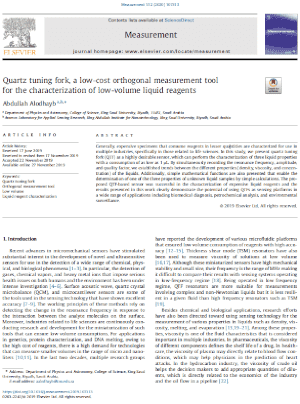Microfluidic cantilever detects bacteria and measures their susceptibility to antibiotics in small confined volumes
Download PDFAbstract: In the fight against drug-resistant bacteria, accurate and high-throughput detection is essential. Here, a bimaterial microcantilever with an embedded microfluidic channel with internal surfaces chemically or physically functionalized with receptors selectively captures the bacteria passing through the channel. Bacterial adsorption inside the cantilever results in changes in the resonance frequency (mass) and cantilever deflection (adsorption stress). The excitation of trapped bacteria using infrared radiation (IR) causes the cantilever to deflect in proportion to the infrared absorption of the bacteria, providing a nanomechanical infrared spectrum for selective identification. We demonstrate the in situ detection and discrimination of Listeria monocytogenes at a concentration of single cell per μl. Trapped Escherichia coli in the microchannel shows a distinct nanomechanical response when exposed to antibiotics. This approach, which combines enrichment with three different modes of detection, can serve as a platform for the development of a portable, high-throughput device for use in the real-time detection of bacteria and their response to antibiotics.
Abstract: This report discusses the first demonstration of electrophoresis assisted time-of-flow mass spectrometry using ‘U’ shaped hollow nanomechanical resonators (HNR). Capillary electrophoresis was coupled with the HNR based mass detection to overcome low ionic conductivity of channels embedded in the HNR preventing direct in-situ electrophoretic separation. The flow of analytes through the HNR was achieved by balancing the hydrodynamic pressure to override the electromotive force and inhibit the motion of analytes towards the anode for capillary electrophoresis. The resonance frequency shifts of the HNR vibrating around 1.5 MHz were correlated with the time of the passage of the protein bands to construct the mass spectrum. The proposed concept was demonstrated by constructing a mass spectrum of egg white proteins in the molecular weight range of 14–250 kDa. When compared to regular polyacrylamide gel electrophoresis, our method not only provides a precise and fast readout but also avoids the use of chemical staining. This study paves a new route for low-cost and on-chip mass spectrometers with ultra-miniaturized dimensions.
Clustering mechanism of ethanol-water mixtures investigated with photothermal microfluidic cantilever deflection spectroscopy
Download PDFAbstract: The infrared-active (IR) vibrational mode of ethanol (EtOH) associated with the asymmetrical stretching of the C-C-O bond in pico-liter volumes of EtOH-water binary mixtures is calorimetrically measured using photothermal microfluidic cantilever deflection spectroscopy (PMCDS). IR absorption by the confined liquid results in wavelength dependent cantilever deflections, thus providing a complementary response to IR absorption revealing a complex dipole moment dependence on mixture concentration. Solvent-induced blue shifts of the C-C-O asymmetric vibrational stretch for both anti and gauche conformers of EtOH were precisely monitored for EtOH concentrations ranging from 20–100% w/w. Variations in IR absorption peak maxima show an inverse dependence on induced EtOH dipole moment (μ) and is attributed to the complex clustering mechanism of EtOH-water mixtures.
Piezotransistive transduction of femtoscale displacement for photoacoustic spectroscopy
Download PDFAbstract:Measurement of femtoscale displacements in the ultrasonic frequency range is attractive for advanced material characterization and sensing, yet major challenges remain in their reliable transduction using non-optical modalities, which can dramatically reduce the size and complexity of the transducer assembly. Here we demonstrate femtoscale displacement transduction using an AlGaN/GaN heterojunction field effect transistor-integrated GaN microcantilever that utilizes piezoelectric polarization-induced changes in two-dimensional electron gas to transduce displacement with very high sensitivity. The piezotransistor demonstrated an ultra-high gauge factor of 8,700 while consuming an extremely low power of 1.36 nW, and transduced external excitation with a superior noise-limited resolution of 12.43 fm Hz−1/2 and an outstanding responsivity of 170 nV fm−1, which is comparable to the optical transduction limits. These extraordinary characteristics, which enabled unique detection of nanogram quantity of analytes using photoacoustic spectroscopy, can be readily exploited in realizing a multitude of novel sensing paradigms.
Nanomechanical identification of liquid reagents in a microfluidic channel
Download PDFAbstract: Integration of promising technologies that can enhance sensitivity, selectivity, and throughput into micro total analysis systems (μTAS) are important in making them useful in precise screening of reaction byproducts in analytical chemistry, cellular biology and pharmaceutical industries. But unfortunately so far a method to precisely determine molecular signatures of reagents is missing in μTAS. We have developed a technique whereby molecular signatures of 50 pL of liquid reagents confined within a bimetallic microchannel cantilever can be obtained. This is achieved using wavelength dependent mechanical bending of the cantilever under infrared (IR) radiation. This technique also allows simultaneous physical characterization of the liquid reagent using variations in resonance frequency. It is useful in lab-on-a-chip devices and has a myriad of applications in drug screening, bioreactor monitoring, and petrochemical analysis.
Thermomechanical responses of microfluidic cantilever capture DNA melting and properties of DNA premelting states using picoliters of DNA solution
Download PDFAbstract: Melting or thermal denaturation of a DNA molecule and the different bubble-rich, premelting DNA states that serve as a precursor for DNA thermal denaturation are vital events in DNA thermophysics. In this study, we employ cantilever-based sensing to firstly pinpoint the occurrence of DNA melting and identify the temperature Tm characterizing the melting. Very importantly, this sensing is carried out with an extremely small volume (∼picoliters) of DNA sample with the cantilever demonstrating an extremely high sensitivity on the order of mJ/g⋅K corresponding to pico-Joules of energy input. Secondly, this same large sensitivity of the cantilever is used to quantify the hitherto unknown thermophysical properties of the bubble-rich DNA premelting states. In fact, for both the melting and premelting states, the cantilever provides a framework to calculate the specific heat capacity and the storage and loss moduli of the cantilever-DNA-solution system, thereby establishing a platform for quantifying DNAs' thermo-mechanical behavior. .
Sample Preparation in Centrifugal Microfluidic Discs for Human Serum Metabolite Analysis by Surface Assisted Laser Desorption/Ionization Mass Spectrometry
Download PDFAbstract: We introduce a centrifugal microfluidic disc that accepts a small volume in (~5 μL), performs sample cleanup on human serum samples, and delivers a small volume out, for subsequent metabolite analysis by surface assisted laser desorption/ionization (SALDI) mass spectrometry (MS) or hydrophilic interaction liquid chromatography (HILIC)-MS. The centrifugal microfluidic disc improves the MS results by removing proteins and lipids from serum. In the case of SALDI-MS, sample background electrolytes are segregated from analytes during the spotting process by the action of the SALDI-chip during drying, for further cleanup, while HILIC separates the salts in HILIC-MS. The resulting mass spectra of disc-prepared samples show a clean background and high signal-to-noise ratio for metabolite peaks. Several representative ionic metabolites from human serum samples were successfully quantified. The performances of the sample preparation disc for SALDI-MS and HILIC-MS were assessed and were comparable. Reproducibility, sample bias, and detection limits for SALDI-MS compared well to ultrafiltration sample preparation.
Nanomechanical Calorimetric Infrared Spectroscopy using Bi-Material Microfluidic Cantilevers
Download PDFAbstract: Receptor-free, in-situ sensing of chemical and biological analytes with high selectivity and sensitivity is a highly sought-after goal. While a resonating microfluidic, hollow channel microcantilever is an ideal platform for sensing pico liters (pL) of liquid analytes based on changes in the specific gravity it does not offer any chemical selectivity. Fabricating these hollow channel cantilevers as bi-material beams allows them to be extremely sensitive to small changes in temperature as well. When a liquid confined in such a cantilever is illuminated with tunable IR radiation, it undergoes bending whenever the liquid analyte absorbs the light at a particular wavelength. Monitoring the cantilever bending as a function of illuminating wavelength provides IR spectrum of the analyte confined in the channel. This method combines the selectivity of IR spectroscopy and the sensitivity of a cantilever for molecular recognition of pL volume of liquid samples. This nanomechanical calorimetric infrared spectroscopy is an ideal technique for physical and chemical characterization of pico liter volumes of liquid analytes.
Thermomechanical behavior of a bimaterial microchannel cantilever subjected to periodic IR radiation
Download PDFAbstract: Here we report the thermomechanical response of a bimaterial microchannel cantilever (BMC) subjected to periodic heating by IR radiation. A detailed theoretical and experimental study was performed considering the BMC as a thermal sensor. Experiments were conducted to find out the thermal sensitivity and power sensitivity of various BMC designs. The thermal sensitivity of the BMC was found by monitoring the response of the BMC to external heating while the power sensitivity was measured by observing its behavior to varying incident IR power. We report a minimum measurement of 60 μW of power, an energy resolution of ∼ 240 nJ and a temperature resolution of 4 mK using the BMC. The optimum BMC design was chosen to demonstrate a spectroscopy application to detect a minimum of 1.15 ng of ethanol in ethanol-water binary mixture. The purpose of this paper is to add molecular selectivity to the ultra-sensitive, novel design of microchannel cantilevers using photothermal spectroscopy techniques for biosensing applications.
Heat capacity measurements of sub-nanoliter volumes of liquids using bimaterial microchannel cantilevers
Download PDFAbstract: Lab-on-a-Chip compatible techniques for thermal characterization of miniaturized volumes of liquid analytes are necessary in applications such as protein blotting, DNA melting, and drug development, where samples are either rare or volume-limited. We developed a closed-chamber calorimeter based on a bimaterial microchannel cantilever (BMC) for sub-nanoliter level thermal analysis. When the liquid-filled BMC is irradiated with infrared (IR) light at a specific wavelength, the IR absorption by the liquid analyte results in localized heat generation and the subsequent deflection of the BMC, due to a thermal expansion mismatch between the constituent materials. The time constant of the deflection, which is dependent upon the heat capacity of the liquid analyte, can be directly measured by recording the time-dependent bending of the BMC. We have used the BMC to quantitatively measure the heat capacity of five volatile organic compounds. With a deflection noise level of ∼10 nm and a signal-to-noise ratio of 68:1, the BMC offers a sensitivity of 30.5 ms/(J g−1 K−1) and a resolution of 23 mJ/(g K) for ∼150 pl liquid for heat capacity measurements. This technique can be used for small-scale thermal characterization of different chemical and biological samples.
Online measurement of mass density and viscosity of pL fluid samples with suspended microchannel resonator
Download PDFAbstract: Physical characterization of viscous samples is crucial in chemical, pharma and petroleum industry. For example, in the refining industry of petroleum, water percentage is verified by measuring the density of a sample. In this article we present a suspended microchannel resonator (SMR) which uses 5 pL of a fluid sample and measures its density with a resolution of 0.01 kg/m3 and a sensitivity of 16 Hz/kg/m3. The resonator can also simultaneously measure viscosity of the solutions with an accuracy of 0.025 mPa s. The SMR is part of a system which contains packaging and tubing to deliver samples to the resonator. The system can easily handle multiple viscous fluids to measure their densities and viscosities. The SMR is transparent, facilitating visual inspection of the microchannel content.
Standoff Mechanical Resonance Spectroscopy Based on Infrared-Sensitive Hydrogel Microcantilevers
Download PDFAbstract:This paper reports a highly sensitive and selective remote chemical sensing platform for surface-adsorbed trace chemicals by using infrared (IR)-sensitive hydrogel microcantilevers. Poly(ethylene glycol) diacrylate (PEG-DA) hydrogel microcantilevers are fabricated by ultraviolet (UV) curing of PEG-DA prepolymer introduced into a poly(dimethylsiloxane) mold. The resonance frequency of a PEG-DA microcantilever exhibits high thermal sensitivity due to IR irradiation/absorption. When a tunable IR laser beam is reflected off a surface coated with target chemical onto a PEG-DA microcantilever, the resonance frequency of the cantilever shifts in proportion to the chemical nature of the target molecules. Dynamic responses of the PEG-DA microcantilever can be obtained in a range of IR wavelengths using a tunable quantum cascade laser that can form the basis for the standoff mechanical resonance spectroscopy (SMRS). Using this SMRS technique, we have selectively detected three compounds, dimethyl methyl phosphonate (DMMP), cyclotrimethylene trinitramine (RDX), and pentaerythritol tetranitrate (PETN), located 4 m away from the PEG-DA microcantilever detector. The experimentally measured limit of detection for PETN trace using the PEG-DA microcantilever was 40 ng/cm2. Overall, the PEG-DA microcantilever is a promising candidate for further exploration and optimization of standoff detection methods.
Thermal Characterization of Liquid Analytes via Photothermal Modulation of Microfluidic Resonators
Download PDFAbstract: This paper reports the first thermal characterization of liquid analytes via photothermal modulation of microfluidic resonators in dynamic mode. Measurements of thermophysical properties of liquid analytes are enabled by real-time tracking of the resonance frequency shift of the microfluidic resonator while the liquid filled resonator is irradiated by a diode laser. The local irradiation induces the photothermal heating of the resonator as well as the loaded liquid sample. The volumetric thermal expansion coefficients of various liquids are correlated with resonance frequency shifts of the resonator and the ratio of specific heat to thermal conductivity tuned by varying the mole fraction of ethanol-water binary mixtures shows linear dependence on the heating time constant. In addition, a higher flexural mode displays improved sensitivity for thermal characterization of liquids via photothermal heating.
Dual Channel Microfluidic Resonators for Simultaneous Measurements of Liquid Analytes
Download PDFAbstract: This paper reports microfluidic resonators with two independent channels integrated for simultaneous measurements of different or same liquid analytes, for the first time. Such a unique design intrinsically enables independent access of each integrated fluidic channel. Therefore, fast sample exchange and simultaneous loading of two different liquids can be guaranteed. Dual channel microfluidic resonators mounted on the custom vacuum clamp are thoroughly characterized with a laser Doppler vibrometer. One of the two channels would be loaded with functional materials to measure liquid properties at modulated conditions.
Analytical Modeling of Microfluidic Cantilever Sensor with Evaporating Ethanol
Download PDFAbstract: Resonating microcantilevers are widely used for myriad biochemical sensing applications. Small samples can be characterized for their physical [1], chemical [2], and thermal [3] properties. An example of such a sensor is shown in Fig. 1, wherein microcantilevers with embedded microfluidic channels have been fabricated using low stress silicon rich SiN. The resonant frequency of these microstructures is very sensitive to mass of the liquid in the microchannel. We measure the evaporation of small volumes of ethanol within the channel and relate the evaporation rate to observed changes in the resonance frequency. Specifically, the microchannel is filled with ethanol and the outlet is then sealed while the inlet is open to ambient air. Due to changing mass density of ethanol as it evaporates, the resonance frequency of the cantilever shifts to a higher value. Understanding the relationship of the resonant modes and frequencies with the changing mass is essential for improving sensitivity and selectivity. During the experiment, the cantilever is sequentially excited at the resonance frequencies of its four vibrational modes (3 times for each mode), as demonstrated in Fig. 2. The nodal points of each mode are sequentially marked from N1 to N14, along the length of the channel. While the cantilever vibrates in its first mode, f1 increases during evaporation from 25.7 kHz to 31.5 kHz, as shown in Fig. 2(a). As the ethanol evaporates, its meniscus travels from the inlet to the outlet and encounters nodal regions, where the cantilever does not sense a change in the mass. This is evident by the flat regions of the curves in Fig. 2. Because the experiment is performed in an uncontrolled ambient environment, the evaporation profiles of the three measurements do not match. Similar experiments are performed to investigate f2, f3 and f4. The higher resonant frequencies f2, f3 and f4 contain more nodes as shown in Fig. 2. We developed numerical and analytical models to predict and understand the resonant behavior of this system. The numerical model employed a 3D elastic finite element based analysis to verify the experimental data for resonant frequencies f1 to f4 and the corresponding mode displacements. The ethanol in the channel is modeled as an elastic material with a very low Young’s modulus, relative to the cantilever material. The predicted increase in the resonant frequencies due to the removal of ethanol in the channel correlates well with experimental data. For the analytical model, we developed a one dimensional beam element model and the predicted resonant frequencies compared to with 95% of the numerical model. These models are useful for rational design and will be discussed in our presentation.
Quartz tuning fork, a low-cost orthogonal measurement tool for the characterization of low-volume liquid reagents
Download PDFAbstract: Generally, expensive specimens that consume reagents in lesser quantities are characterized for use in multiple industries, specifically in those related to life sciences. In this study, we present quartz tuning fork (QTF) as a highly desirable sensor, which can perform the characterization of three liquid properties with a consumption of as low as 1 µL. By simultaneously recording the resonance frequency, amplitude, and quality factor, we established trends between the different properties (density, viscosity, and concentration) of the liquids. Additionally, simple mathematical functions are also presented that enable the determination of one of the three properties of unknown liquid samples by simple calculations. The proposed QTF-based sensor was successful in the characterization of expensive liquid reagents and the results presented in this work clearly demonstrate the potential of using QTFs as sensing platforms in a wide range of applications including biomedical diagnosis, petrochemical analysis, and environmental surveillance.
